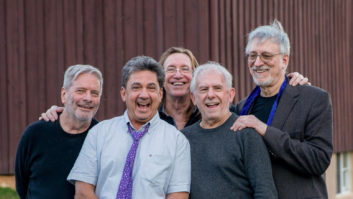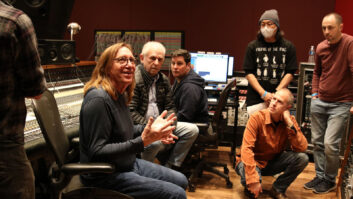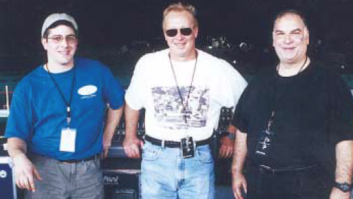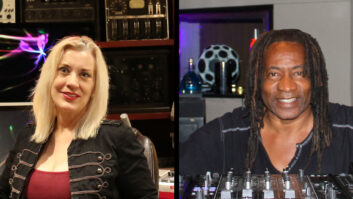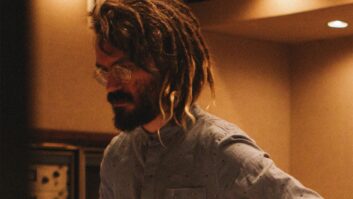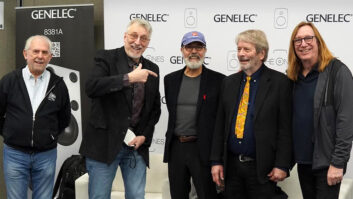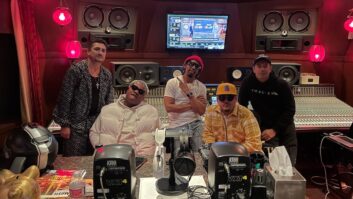In the last couple of years, veteran engineer Elliot Scheiner has become one of the recording world’s most passionate and articulate advocates of 5.1 mixing. He is also responsible for some of the best music work done in the surround format-listen to his brilliant mixes of The Eagles’ Hell Freezes Over and Fleetwood Mac’s The Dance on DVD. His most recent 5.1 mixing project was Sting’s Brand New Day, which was recorded primarily by Simon Osborne at Sting’s villa in Tuscany and mixed (to stereo) at Mega in Paris on an SSL. Sheiner likes to do his 5.1 mixing at Presence Studios in humble ol’ Connecticut, which is “close to me, just 15 minutes away, and it’s got a [Neve] VR in it, a digital machine, an analog machine, a Fairlight system-it couldn’t be any more perfect,” he says.
We talked to Scheiner recently about the Sting album and more generally about 5.1.
What are you learning as you go from project to project-from The Eagles to Fleetwood Mac to Sting?
The one major thing I’ve learned is the use of the center speaker-what to use it for and what not to use it for. My current thinking is to not use it for too much of anything. The first [5.1] mix I did was for The Eagles, and I didn’t really understand what the center speaker was for; it seemed weird to have a center speaker. I didn’t realize that it was primarily a film thing-it’s basically a dialog track in film. So I was given somewhat erroneous information; I was told, “Use it for something you want to accent, something you want to bring to someone’s attention.” I should have known then and there that was a mistake. And actually, on one of the mixes, I put the lead vocal in the center speaker and nothing else. Fortunately, it’s a great vocal, and anybody who wants to turn off every other speaker and just hear the voice, it’s okay, but I wouldn’t do that again.
Then there’s the whole question of what you use the rear [speakers] for. When a lot of film mixers do scoring, they set up the room with ambient mics and all you hear coming out of the rear are the ambient mics. But I’m a big believer in using the rear speakers for more than that-we’ve got the speakers, let’s use them. I think if the upcoming buyer of a DVD is going to spend some money, they want to hear more than just some reverbs out of the rear. They’re paying a higher price for the piece, and I think they want to be blown away. I think they want to experience something new. So I tend to surround the listener with music. I take chances. I’ll put strange things in the rear. I’ll put a set of drums in the rear. It won’t be the primary set, maybe, but I’ve put a second drum set in the rear. Or if there are loops, I’ll shove those in the rear.
As stereo across the rear?
Most of the time. But yesterday I called this film mixer on this film I’m working on, Pokemon, and he said, “Do whatever you want. I’m up for it.” That was nice to hear-that someone in the film community was okay with doing a music-all-around approach.
On the Sting project, you were starting from Simon Osborne’s stereo mixes.
He came to Connecticut. I like using this room because it’s perfectly aligned for 5.1 for me. I do all my 5.1 there if I can. I have a Panasonic DA7, and I use that in conjunction with the VR. They had done an 80-channel mix. There was a lot of programming on it. There’s a lot of orchestra. A lot of effects. A lot of vocals. And it’s absolutely astounding in 5.1.
What sort of decisions did you have to make particular to this record?
It was a perfect record to do in 5.1 because it had so much to draw from. I had the option to do pretty much whatever I wanted. I called [Sting’s manager] Miles Copeland before I started and said, “Look, I really like to experiment. I put a lot of music in the surrounds,” and he was fine with that. He said,
“Go for it. Sting is very experimental himself.”
When you sit down in a 5.1 room, you’re right in the middle of this whole band.
What did you do with the orchestra?
Eighty percent of the time I put it in the rear.
When you’re sitting there in the midst of this, are you trying to establish a visual picture of where the instruments are sitting, so you might have the band in front of the orchestra, literally?
Not really. It’s more like the band is in front of me and the orchestra is behind me, like I’m sitting in between them. On another track you might want it to feel as though everyone is in a circle around you and you’re facing the main band. With all the previous live projects I’ve done with Fogerty and The Eagles and Fleetwood, I wanted to just put the listener onstage. I always made the focus point the band. But anyone who wasn’t one of the five or six guys in the band I’d put in the surround-maybe the extra keyboard player or the extra guitar players or the orchestra or any soloists. When you’re sitting there and you hear the audience behind you and to the side of you, you expect everything to come from the front, and then all of a sudden you realize you’re onstage. It really doesn’t matter what sort of visual picture anyone gets from it; I just want them to be engrossed by the entire experience.
What did you tend to do with Sting’s vocal?
It’s always up front, left-right with just a touch of it in the center. Primarily what I use the center for now is I put a little bit of lead vocal in there, a little bit of the bass, a little bit of the snare, a little bit of bass drum and that’s pretty much it.
So did you essentially have to mix from scratch using the 80 tracks?
Close to it. Basically what would happen is Simon would come in, we’d pull up the multitrack, and he would pretty much get the EQ that existed on the stereo [mix]. You know, if someone went out and bought the stereo and then bought the 5.1, I wouldn’t want it to be jarring for them by emphasizing a lot of different things. So I try and maintain the sound that Simon had, though I punched up a few things differently, like the kick and the snare; those are a little different than the original stereo mix, but having the subwoofer [in a 5.1 mix] it’s never going to sound exactly the same as the stereo.
By definition, though, doesn’t the spatial dimension change the emphasis of certain parts?
Of course it can, and it usually does. It creates such a great amount of space. You’re not shoving everything into just two speakers. In a 5.1, you can pretty much pick out any element you want.
I feel as though we have to re-train our ears and our brains to listen to 5.1. It takes a bit of mental work to absorb it.
It can be a little tricky. I think people such as you, people who are in the business, are obviously going to be more open to this and really get a lot out of it immediately. We’re going to see the biggest change happening in the market when the automobile manufacturers start installing DVDs in cars. People are going to be blown away.
When I mixed Fleetwood Mac, none of them were around when I was doing the 5.1. Finally, the very last night, I got them to come in, and I crammed them in this little space in the studio in the middle of the speakers, and when I played the 5.1 for them their mouths dropped. Lindsey Buckingham said, “I don’t think I can ever listen to stereo again.” That says a lot. I think it’s going to be hard for a lot of people to go back to stereo.
How do you work with programmed and/or sequenced information? Are there any different requirements in terms of reverbs or effects with 5.1?
It depends on how they’re used in the original mix. If it was a fairly important element, chances are it’ll be up front, and if there’s a lot of stuff going on, I may put it in the rear as well, so I can maintain the imagery up front and have this jamming at you in the back, too. There are so many options in 5.1, and so far there are almost no rules.
What speakers do you monitor on?
I use KRKs; they’ve been really good so far.
It seems as though in the first wave of people who bought home surround systems a lot of them would use smaller, cheaper rear speakers so there was always a sonic imbalance in the way the information was transmitted to the listener.
That’s been a problem. And the reason it happened that way is that it’s a film industry thing-for what they were using the rear speakers for in their mixes, they didn’t really need full-range speakers all around. So the small satellite speakers were fine for them. And the manufacturers followed suit and made systems with three mains-and sometimes even the center wasn’t the same-and then two completely different surrounds. Now that music’s getting done in 5.1, everyone’s wondering if they should be full-range all around. I don’t think we can dictate to someone where to put the speakers in their home. Sometimes people don’t have room in the rear. Sometimes, because of where their furniture sits, they have to put the rear speakers off to the side. That’s okay; it’s a different effect but you still get some 5.1 benefit out of it. I think as we get more into it, a lot of people are going to dedicate rooms to it. Especially with hi-def [TV] coming, I think people are going to go crazy with home theaters.
Say good-bye to the home office; now it’ll be theaters.
I hope so. It could be a perfect listening environment. I can’t tell you how many times I’ve gone into people’s houses and heard my records on their systems and thought, “Wow, this is terrible!” [Laughs.] So I’m in favor of everyone upgrading their systems.
What are the limitations of the technology at this point? If the center channel is worthless, why have it at all?
I don’t know that we need it.
So quad was the way to go after all!
Could be. Alan Parsons is doing 5.1 but basically he’s doing quad, and his stuff sounds amazing. I think he’s using a phantom center. We’ll need to retain the center, though, because that’s what the film industry does and we have to accommodate that if we’re going to share the same technology.
You’re becoming Mister 5.1.
Well, I’m a big advocate. I really support it. I love doing it. For me, creatively, it’s a gas.
How do you think it would change what you do if you were on the project from the beginning rather than coming in at the end as a 5.1 mixer?
I do a lot of projects from the beginning where there’s stereo first. I always now think that it might go 5.1, so if I’m doing a studio record, I’ll set up ambient mics in the room so I have some ambient drum tracks, for instance. But beyond that, nothing much more. I think the venue that benefits most is the live recording; that’s a wonderful medium, especially if there’s a video with it.
At this stage, the Stings and Fleetwood Macs of the world are going 5.1. When is it going to trickle down to smaller projects?
It’s hard to say. The record companies are being pretty selective right now until they see what’s happening in the marketplace. I know they’d love to be mixing more in 5.1, but they don’t want to pay for it.
The record companies are doing some despicable things. Like right now they’re trying to take some classic records and remix them in 5.1, because they know the marketplace is an older demographic, so they think people will pay more money for a 5.1 of say [Steely Dan’s] Gaucho or [The Eagle’s] Hotel California. So record companies are going to the original guys who mixed some classic records and saying, “We want to redo this, but we can’t afford you,” so they end up getting the guy’s assistant to do it much more cheaply. So it’s a guy who shouldn’t be mixing to begin with, and here is mixing in 5.1! The integrity of the original is at stake, especially when you’ve got a record company guy saying, “Oh, don’t worry about what the original reverbs were. Use these new digital reverbs, it’ll be fine.” And, in fact, the record might sound okay because it’s in 5.1. But it might not have any bearing or resemblance to what the original record was. I think you have to maintain some kind of integrity. In this one case I’m referring to, the artist is no longer alive, and the estate doesn’t really care. In general, I hope the artists will get involved when someone from either their current record company or their old record company wants to remix something in 5.1 and doesn’t want to consult them
on it.
Well, look at the early days of remastering for CD, when the bands were almost never involved and some real crap got out there.
That’s true, but there you’re talking about remastering and the fact is most of the bands weren’t involved in the mastering of their records anyway. But I know what you’re saying. I’m talking about actual remixing; that’s a different thing.
Are there any projects you’ve been involved with where you’ve really been able to go crazy and do weird stuff yet?
Not really, because so far everything that I’ve put in 5.1 had already been released in stereo, so there’s an integrity I’ve had to maintain.
But you’re champing at the bit; I can tell!
Oh, yeah! The closest I came was when I remixed a Toy Matinee record; it was their first album, one that Bill Bottrell had mixed originally. And it came out unbelievable! I had stuff marching around the speakers. It was very cool.
On the Sting record I’ve got a 360-degree pan happening on a couple of things in there. Like in one case, it’s like a scratch that I have going around; it sounds great.
I would think it would be hard to do that and not have it sound gimmicky.
Well, it depends on how loud it is. On the Sting record, it’s almost subliminal because it is what it is, but for a second you get the impression you may be listening to vinyl.
How long did the Sting project take you?
About two weeks; it was a little bit more than a song a day. I like this record a lot. It’s really well-made. I think it’s got a bit more of a world music feeling than some of his records. His voice is amazing. It’s very cool. And it sounds that much better in 5.1!

